+ Open data
Open data
- Basic information
Basic information
| Entry | Database: PDB / ID: 6qg8 | ||||||
|---|---|---|---|---|---|---|---|
| Title | Structure of human Bcl-2 in complex with PUMA BH3 peptide | ||||||
 Components Components |
| ||||||
 Keywords Keywords | APOPTOSIS / MCL1 / BCL2 / PUMA | ||||||
| Function / homology |  Function and homology information Function and homology informationpositive regulation of establishment of protein localization to mitochondrion / negative regulation of cellular pH reduction / negative regulation of retinal cell programmed cell death / pigment granule organization / channel inhibitor activity / CD8-positive, alpha-beta T cell lineage commitment / BAD-BCL-2 complex / regulation of glycoprotein biosynthetic process / melanin metabolic process / positive regulation of skeletal muscle fiber development ...positive regulation of establishment of protein localization to mitochondrion / negative regulation of cellular pH reduction / negative regulation of retinal cell programmed cell death / pigment granule organization / channel inhibitor activity / CD8-positive, alpha-beta T cell lineage commitment / BAD-BCL-2 complex / regulation of glycoprotein biosynthetic process / melanin metabolic process / positive regulation of skeletal muscle fiber development / positive regulation of melanocyte differentiation / myeloid cell apoptotic process / osteoblast proliferation / cochlear nucleus development / mesenchymal cell development / retinal cell programmed cell death / positive regulation of neuron maturation / positive regulation of endoplasmic reticulum stress-induced intrinsic apoptotic signaling pathway / negative regulation of osteoblast proliferation / negative regulation of growth / positive regulation of fibroblast apoptotic process / gland morphogenesis / renal system process / apoptotic process in bone marrow cell / regulation of cell-matrix adhesion / T cell apoptotic process / stem cell development / negative regulation of calcium ion transport into cytosol / melanocyte differentiation / SARS-CoV-1-mediated effects on programmed cell death / The NLRP1 inflammasome / dendritic cell apoptotic process / ear development / lymphoid progenitor cell differentiation / dendritic cell proliferation / positive regulation of mononuclear cell proliferation / negative regulation of myeloid cell apoptotic process / negative regulation of epithelial cell apoptotic process / regulation of nitrogen utilization / BH3-only proteins associate with and inactivate anti-apoptotic BCL-2 members / B cell apoptotic process / negative regulation of intrinsic apoptotic signaling pathway in response to DNA damage / negative regulation of T cell apoptotic process / glomerulus development / negative regulation of execution phase of apoptosis / negative regulation of dendritic cell apoptotic process / oocyte development / positive regulation of multicellular organism growth / metanephros development / neuron maturation / negative regulation of mitochondrial outer membrane permeabilization involved in apoptotic signaling pathway / positive regulation of cysteine-type endopeptidase activity / regulation of viral genome replication / negative regulation of motor neuron apoptotic process / focal adhesion assembly / endoplasmic reticulum calcium ion homeostasis / fertilization / negative regulation of ossification / negative regulation of B cell apoptotic process / response to UV-B / regulation of mitochondrial membrane permeability / response to iron ion / positive regulation of thymocyte apoptotic process / negative regulation of protein localization to plasma membrane / regulation of growth / calcium ion transport into cytosol / channel activity / negative regulation of mitochondrial depolarization / motor neuron apoptotic process / fibroblast apoptotic process / execution phase of apoptosis / Bcl-2 family protein complex / axon regeneration / Activation of PUMA and translocation to mitochondria / epithelial cell apoptotic process / smooth muscle cell migration / intrinsic apoptotic signaling pathway in response to oxidative stress / NFE2L2 regulating tumorigenic genes / FOXO-mediated transcription of cell death genes / organ growth / digestive tract morphogenesis / branching involved in ureteric bud morphogenesis / response to cycloheximide / hair follicle morphogenesis / negative regulation of G1/S transition of mitotic cell cycle / : / negative regulation of intrinsic apoptotic signaling pathway in response to DNA damage by p53 class mediator / cellular response to alkaloid / STAT5 activation downstream of FLT3 ITD mutants / B cell lineage commitment / hepatocyte apoptotic process / pore complex / positive regulation of smooth muscle cell migration / B cell proliferation / negative regulation of reproductive process / negative regulation of developmental process / negative regulation of release of cytochrome c from mitochondria / T cell homeostasis / BH3 domain binding / germ cell development Similarity search - Function | ||||||
| Biological species |  Homo sapiens (human) Homo sapiens (human) | ||||||
| Method |  X-RAY DIFFRACTION / X-RAY DIFFRACTION /  SYNCHROTRON / SYNCHROTRON /  MOLECULAR REPLACEMENT / Resolution: 1.9 Å MOLECULAR REPLACEMENT / Resolution: 1.9 Å | ||||||
 Authors Authors | Dokurno, P. / Murray, J. / Davidson, J. / Chen, I. / Davis, B. / Graham, C.J. / Harris, R. / Jordan, A.M. / Matassova, N. / Pedder, C. ...Dokurno, P. / Murray, J. / Davidson, J. / Chen, I. / Davis, B. / Graham, C.J. / Harris, R. / Jordan, A.M. / Matassova, N. / Pedder, C. / Ray, S. / Roughley, S. / Smith, J. / Walmsley, C. / Wang, Y. / Whitehead, N. / Williamson, D.S. / Casara, P. / Le Diguarher, T. / Hickman, J. / Stark, J. / Kotschy, A. / Geneste, O. / Hubbard, R.E. | ||||||
 Citation Citation |  Journal: Acs Omega / Year: 2019 Journal: Acs Omega / Year: 2019Title: Establishing Drug Discovery and Identification of Hit Series for the Anti-apoptotic Proteins, Bcl-2 and Mcl-1. Authors: Murray, J.B. / Davidson, J. / Chen, I. / Davis, B. / Dokurno, P. / Graham, C.J. / Harris, R. / Jordan, A. / Matassova, N. / Pedder, C. / Ray, S. / Roughley, S.D. / Smith, J. / Walmsley, C. / ...Authors: Murray, J.B. / Davidson, J. / Chen, I. / Davis, B. / Dokurno, P. / Graham, C.J. / Harris, R. / Jordan, A. / Matassova, N. / Pedder, C. / Ray, S. / Roughley, S.D. / Smith, J. / Walmsley, C. / Wang, Y. / Whitehead, N. / Williamson, D.S. / Casara, P. / Le Diguarher, T. / Hickman, J. / Stark, J. / Kotschy, A. / Geneste, O. / Hubbard, R.E. | ||||||
| History |
|
- Structure visualization
Structure visualization
| Structure viewer | Molecule:  Molmil Molmil Jmol/JSmol Jmol/JSmol |
|---|
- Downloads & links
Downloads & links
- Download
Download
| PDBx/mmCIF format |  6qg8.cif.gz 6qg8.cif.gz | 50.9 KB | Display |  PDBx/mmCIF format PDBx/mmCIF format |
|---|---|---|---|---|
| PDB format |  pdb6qg8.ent.gz pdb6qg8.ent.gz | 34.2 KB | Display |  PDB format PDB format |
| PDBx/mmJSON format |  6qg8.json.gz 6qg8.json.gz | Tree view |  PDBx/mmJSON format PDBx/mmJSON format | |
| Others |  Other downloads Other downloads |
-Validation report
| Summary document |  6qg8_validation.pdf.gz 6qg8_validation.pdf.gz | 440.4 KB | Display |  wwPDB validaton report wwPDB validaton report |
|---|---|---|---|---|
| Full document |  6qg8_full_validation.pdf.gz 6qg8_full_validation.pdf.gz | 441 KB | Display | |
| Data in XML |  6qg8_validation.xml.gz 6qg8_validation.xml.gz | 9.6 KB | Display | |
| Data in CIF |  6qg8_validation.cif.gz 6qg8_validation.cif.gz | 13.2 KB | Display | |
| Arichive directory |  https://data.pdbj.org/pub/pdb/validation_reports/qg/6qg8 https://data.pdbj.org/pub/pdb/validation_reports/qg/6qg8 ftp://data.pdbj.org/pub/pdb/validation_reports/qg/6qg8 ftp://data.pdbj.org/pub/pdb/validation_reports/qg/6qg8 | HTTPS FTP |
-Related structure data
| Related structure data |  6qfiC  6qfmC 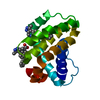 6qfqC 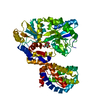 6qgdC  6qggC  6qghC  6qgjC  6qgkC  2yxjS C: citing same article ( S: Starting model for refinement |
|---|---|
| Similar structure data |
- Links
Links
- Assembly
Assembly
| Deposited unit | 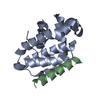
| ||||||||
|---|---|---|---|---|---|---|---|---|---|
| 1 |
| ||||||||
| Unit cell |
|
- Components
Components
| #1: Protein | Mass: 20442.461 Da / Num. of mol.: 1 Mutation: H20S, L95Q, R106L, F124G, R127Y, G128A, R129S, P168V, L175A, T178A, E179T, R183D Source method: isolated from a genetically manipulated source Source: (gene. exp.)  Homo sapiens (human) / Gene: BCL2, BCL2L1, BCL2L, BCLX / Production host: Homo sapiens (human) / Gene: BCL2, BCL2L1, BCL2L, BCLX / Production host:  |
|---|---|
| #2: Protein/peptide | Mass: 2747.998 Da / Num. of mol.: 1 / Source method: obtained synthetically / Source: (synth.)  Homo sapiens (human) / References: UniProt: Q9BXH1 Homo sapiens (human) / References: UniProt: Q9BXH1 |
| #3: Water | ChemComp-HOH / |
-Experimental details
-Experiment
| Experiment | Method:  X-RAY DIFFRACTION / Number of used crystals: 1 X-RAY DIFFRACTION / Number of used crystals: 1 |
|---|
- Sample preparation
Sample preparation
| Crystal | Density Matthews: 2.05 Å3/Da / Density % sol: 40.11 % |
|---|---|
| Crystal grow | Temperature: 284 K / Method: vapor diffusion, sitting drop / pH: 5.5 Details: from 0.2M MgCl2, 25% PegMME 2k, 0.1M Na Acetate buffer pH 5.5 |
-Data collection
| Diffraction | Mean temperature: 100 K / Serial crystal experiment: N | |||||||||||||||||||||||||||||||||||||||||||||||||||||||||||||||||||||||||||||
|---|---|---|---|---|---|---|---|---|---|---|---|---|---|---|---|---|---|---|---|---|---|---|---|---|---|---|---|---|---|---|---|---|---|---|---|---|---|---|---|---|---|---|---|---|---|---|---|---|---|---|---|---|---|---|---|---|---|---|---|---|---|---|---|---|---|---|---|---|---|---|---|---|---|---|---|---|---|---|
| Diffraction source | Source:  SYNCHROTRON / Site: SYNCHROTRON / Site:  ESRF ESRF  / Beamline: ID29 / Wavelength: 0.979 Å / Beamline: ID29 / Wavelength: 0.979 Å | |||||||||||||||||||||||||||||||||||||||||||||||||||||||||||||||||||||||||||||
| Detector | Type: ADSC QUANTUM 315 / Detector: CCD / Date: Nov 5, 2008 | |||||||||||||||||||||||||||||||||||||||||||||||||||||||||||||||||||||||||||||
| Radiation | Monochromator: Mirrors / Protocol: SINGLE WAVELENGTH / Monochromatic (M) / Laue (L): M / Scattering type: x-ray | |||||||||||||||||||||||||||||||||||||||||||||||||||||||||||||||||||||||||||||
| Radiation wavelength | Wavelength: 0.979 Å / Relative weight: 1 | |||||||||||||||||||||||||||||||||||||||||||||||||||||||||||||||||||||||||||||
| Reflection | Resolution: 1.8→50 Å / Num. obs: 13577 / % possible obs: 75 % / Redundancy: 3.5 % / Rmerge(I) obs: 0.111 / Χ2: 1.207 / Net I/σ(I): 7.1 / Num. measured all: 47632 | |||||||||||||||||||||||||||||||||||||||||||||||||||||||||||||||||||||||||||||
| Reflection shell |
|
- Processing
Processing
| Software |
| ||||||||||||||||||||||||||||||||||||||||||||||||||||||||||||
|---|---|---|---|---|---|---|---|---|---|---|---|---|---|---|---|---|---|---|---|---|---|---|---|---|---|---|---|---|---|---|---|---|---|---|---|---|---|---|---|---|---|---|---|---|---|---|---|---|---|---|---|---|---|---|---|---|---|---|---|---|---|
| Refinement | Method to determine structure:  MOLECULAR REPLACEMENT MOLECULAR REPLACEMENTStarting model: 2yxj Resolution: 1.9→20 Å / Cor.coef. Fo:Fc: 0.962 / Cor.coef. Fo:Fc free: 0.935 / SU B: 3.522 / SU ML: 0.099 / SU R Cruickshank DPI: 0.1597 / Cross valid method: THROUGHOUT / σ(F): 0 / ESU R: 0.16 / ESU R Free: 0.15 Details: HYDROGENS HAVE BEEN ADDED IN THE RIDING POSITIONS U VALUES : REFINED INDIVIDUALLY
| ||||||||||||||||||||||||||||||||||||||||||||||||||||||||||||
| Solvent computation | Ion probe radii: 0.8 Å / Shrinkage radii: 0.8 Å / VDW probe radii: 1.2 Å | ||||||||||||||||||||||||||||||||||||||||||||||||||||||||||||
| Displacement parameters | Biso max: 96 Å2 / Biso mean: 29.333 Å2 / Biso min: 15.64 Å2
| ||||||||||||||||||||||||||||||||||||||||||||||||||||||||||||
| Refinement step | Cycle: final / Resolution: 1.9→20 Å
| ||||||||||||||||||||||||||||||||||||||||||||||||||||||||||||
| Refine LS restraints |
| ||||||||||||||||||||||||||||||||||||||||||||||||||||||||||||
| LS refinement shell | Resolution: 1.9→2.002 Å / Rfactor Rfree error: 0 / Total num. of bins used: 10
|
 Movie
Movie Controller
Controller



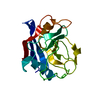
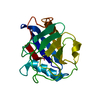
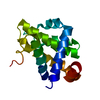
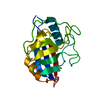
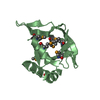

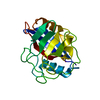
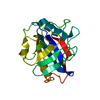
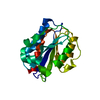
 PDBj
PDBj










